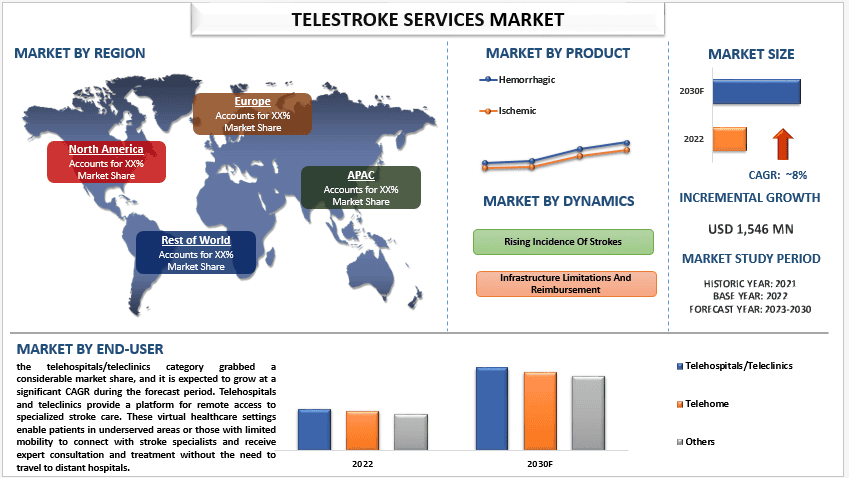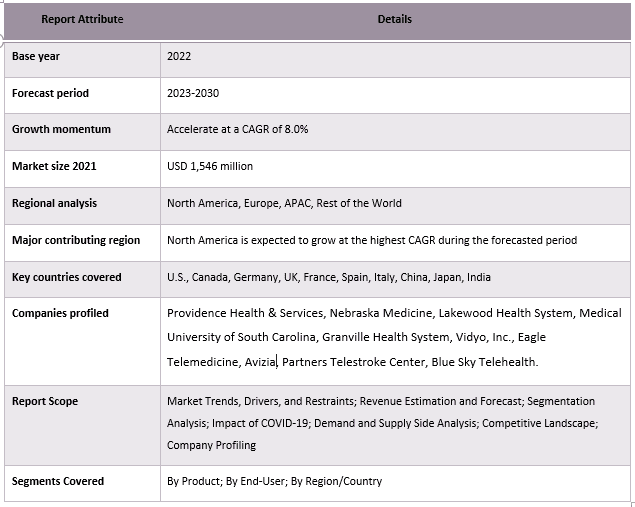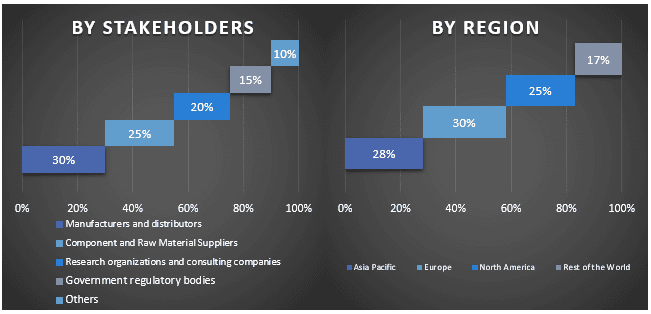- Home
- Chi siamo
- Settore
- Servizi
- Lettura
- Contattaci
Mercato dei servizi di telestroke: analisi attuale e previsioni (2022-2030)
Focus sul prodotto (ischemico, emorragico); Utenti finali (Teleospedali/Telecliniche, Teleassistenza domiciliare, Altro) e Regione/Paese

Il mercato dei servizi di Telestroke è stato valutato a 1.546 milioni di dollari nel 2022 e si prevede che crescerà a un CAGR dell'8% dal 2023 al 2030 Il mercato dei servizi di telestroke si riferisce alla fornitura di servizi di assistenza e consulenza remota per l'ictus attraverso telecomunicazioni e tecnologie digitali. Comporta l'uso di piattaforme di telemedicina e strumenti di comunicazione in tempo reale per connettere specialisti dell'ictus con pazienti in località remote o aree svantaggiate. L'obiettivo principale dei servizi di telestroke è migliorare l'accesso a cure specialistiche e tempestive per l'ictus, in particolare nelle aree che non dispongono di accesso immediato a competenze specifiche per l'ictus. Nel mercato dei servizi di telestroke, gli operatori sanitari sfruttano la teleconferenza, la videoconferenza e la trasmissione sicura dei dati per consentire consultazioni a distanza tra specialisti dell'ictus e pazienti o operatori sanitari locali. Attraverso questi incontri virtuali, gli specialisti dell'ictus possono valutare i sintomi dei pazienti, rivedere immagini mediche come le TAC e fornire una guida esperta agli operatori sanitari locali sulla diagnosi, le decisioni terapeutiche e la gestione dei casi di ictus acuto. La crescente domanda di servizi di telestroke può essere attribuita alla crescente incidenza di ictus in tutto il mondo. Ad esempio, secondo il CDC, ogni 3 minuti e 14 secondi, qualcuno muore di ictus. Ogni anno, più di 795.000 persone negli Stati Uniti hanno un ictus. Circa 610.000 di questi sono primi o nuovi ictus. Circa 185.000 ictus, quasi 1 su 4, si verificano in persone che hanno avuto un ictus precedente. A causa delle evidenti statistiche, gli ictus sono una delle principali cause di disabilità e mortalità e la domanda di cure specialistiche per l'ictus è in crescita in tutto il mondo e contribuirà alla crescita del mercato anche nel prossimo periodo. Inoltre, si prevede che il mercato dei servizi di telestroke crescerà a causa dei servizi di telestroke che colmano questa lacuna fornendo consulenze a distanza e una guida esperta agli operatori sanitari locali. Ciò amplia l'accesso alle cure specialistiche per l'ictus e garantisce che i pazienti ricevano un trattamento appropriato indipendentemente dalla loro posizione. Inoltre, i progressi nell'infrastruttura di telecomunicazione, Internet ad alta velocità e le tecnologie digitali per la salute hanno contribuito in modo significativo alla crescita del mercato dei servizi di telestroke. Tuttavia, alcuni dei vincoli del mercato, tra cui le limitazioni infrastrutturali e le barriere di rimborso e finanziarie, stanno ostacolando la crescita di questo mercato in tutto il mondo.
Alcuni dei principali operatori che operano nel mercato includono Providence Health & Services, Nebraska Medicine, Lakewood Health System, Medical University of South Carolina, Granville Health System, Vidyo, Inc., Eagle Telemedicine, Avizia, Partners Telestroke Center, Blue Sky Telehealth. Diverse fusioni e acquisizioni insieme a partnership sono state intraprese da questi attori per facilitare i clienti con prodotti/tecnologie hi-tech e innovative.
Approfondimenti presentati nel rapporto
"Tra i prodotti, il segmento emorragico ha detenuto una quota significativa del mercato nel 2021."
In base al prodotto, il mercato è segmentato in ischemico ed emorragico. Tra questi, il segmento emorragico ha catturato una quota significativa del mercato nel 2021. L'ictus emorragico, che si verifica a causa di un sanguinamento nel cervello, rappresenta una parte significativa di tutti gli ictus. L'incidenza dell'ictus emorragico è in aumento a livello globale, guidata da fattori quali ipertensione, invecchiamento della popolazione e cambiamenti nello stile di vita. Questa crescente prevalenza contribuisce alla crescente domanda di cure e interventi specialistici per i pazienti con ictus emorragico.
"Tra gli utenti finali, il segmento degli teleospedali/telecliniche ha mantenuto il CAGR più elevato nel mercato nel 2021."
In base all'utente finale, il mercato dei servizi di telestroke è stato classificato in teleospedali/telecliniche, telehome e altri. Tra questi, la categoria teleospedali/telecliniche ha conquistato una quota di mercato considerevole e si prevede che crescerà a un CAGR significativo durante il periodo di previsione. Teleospedali e telecliniche forniscono una piattaforma per l'accesso remoto a cure specialistiche per l'ictus. Queste strutture sanitarie virtuali consentono ai pazienti in aree svantaggiate o a quelli con mobilità limitata di connettersi con specialisti dell'ictus e ricevere consulenza e cure specialistiche senza la necessità di recarsi in ospedali distanti. Questo migliore accesso alle cure specialistiche per l'ictus è un fattore chiave della crescita nel segmento teleospedali/telecliniche.
"Il Nord America ha dominato il mercato dei servizi Telestroke nel 2021."
Il Nord America, in particolare gli Stati Uniti, è un centro per la ricerca biotecnologica e farmaceutica. L'incidenza di ictus in Nord America è in costante aumento, principalmente a causa di fattori quali l'invecchiamento della popolazione, gli stili di vita sedentari e la prevalenza di fattori di rischio come l'ipertensione e il diabete. La crescente incidenza di ictus guida la domanda di servizi di telestroke per fornire cure tempestive e specialistiche. Inoltre, alcune regioni del Nord America devono affrontare una carenza di specialisti dell'ictus, in particolare nelle aree rurali o svantaggiate. I servizi di telestroke aiutano ad affrontare questa carenza collegando gli operatori sanitari locali con specialisti dell'ictus a distanza, consentendo ai pazienti di ricevere una consulenza esperta tempestiva e una guida al trattamento. Il Nord America beneficia di una solida infrastruttura di telecomunicazione e dei progressi nelle tecnologie digitali per la salute. La connettività Internet ad alta velocità, le piattaforme di videoconferenza sicure e le applicazioni di telemedicina hanno facilitato la crescita dei servizi di telestroke, consentendo consultazioni a distanza efficienti e affidabili. Ad esempio, nel 2021, InTouch Health, una delle principali società di telemedicina, si è fusa con Teladoc Health, un importante fornitore di teleassistenza. La fusione ha riunito la loro esperienza nella telemedicina e nei servizi di telestroke, ampliando l'accesso alle cure specialistiche per l'ictus in tutto il Nord America.
Copertura del rapporto sul mercato dei servizi di telestroke

Motivi per acquistare questo rapporto:
- Lo studio include l'analisi della dimensione e della previsione del mercato convalidata da esperti chiave del settore autenticati.
- Il rapporto presenta una rapida panoramica delle prestazioni complessive del settore a colpo d'occhio.
- Il rapporto copre un'analisi approfondita dei principali concorrenti del settore con un focus primario sulle principali risorse finanziarie aziendali, portafogli di prodotti, strategie di espansione e sviluppi recenti.
- Esame dettagliato dei driver, dei vincoli, delle tendenze chiave e delle opportunità prevalenti nel settore.
- Lo studio copre in modo completo il mercato in diversi segmenti.
- Analisi approfondita a livello regionale del settore.
Opzioni di personalizzazione:
Il mercato globale dei servizi di Telestroke può essere ulteriormente personalizzato in base alle esigenze o a qualsiasi altro segmento di mercato. Oltre a questo, UMI comprende che potresti avere le tue esigenze aziendali, quindi sentiti libero di metterti in contatto con noi per ottenere un rapporto che si adatti completamente alle tue esigenze.
Indice
Metodologia di ricerca per l'analisi del mercato dei servizi di Telestroke (2022-2030)
L'analisi del mercato storico, la stima del mercato attuale e la previsione del mercato futuro del mercato globale dei servizi di Telestroke sono stati i tre passaggi principali intrapresi per creare e analizzare l'adozione dei servizi di Telestroke nelle principali regioni a livello globale. È stata condotta un'esauriente ricerca secondaria per raccogliere i dati di mercato storici e stimare le dimensioni attuali del mercato. In secondo luogo, per convalidare queste intuizioni, sono stati presi in considerazione numerosi risultati e ipotesi. Inoltre, sono state condotte anche esaustive interviste primarie con esperti del settore lungo tutta la catena del valore del mercato globale dei servizi di Telestroke. Dopo l'ipotesi e la convalida dei dati di mercato attraverso interviste primarie, abbiamo impiegato un approccio top-down/bottom-up per prevedere le dimensioni complete del mercato. Successivamente, sono stati adottati metodi di suddivisione del mercato e di triangolazione dei dati per stimare e analizzare le dimensioni del mercato dei segmenti e sottosegmenti del settore di riferimento. La metodologia dettagliata è spiegata di seguito:
Analisi delle dimensioni storiche del mercato
Passo 1: Studio approfondito delle fonti secondarie:
È stato condotto uno studio secondario dettagliato per ottenere le dimensioni storiche del mercato dei servizi di Telestroke attraverso fonti interne all'azienda come relazioni annuali e bilanci, presentazioni sulle prestazioni, comunicati stampa, ecc. e fonti esterne tra cui riviste, notizie e articoli, pubblicazioni governative, pubblicazioni della concorrenza, relazioni di settore, database di terze parti e altre pubblicazioni credibili.
Passo 2: Segmentazione del mercato:
Dopo aver ottenuto le dimensioni storiche del mercato dei servizi di Telestroke, abbiamo condotto un'analisi secondaria dettagliata per raccogliere informazioni storiche sul mercato e quote di mercato per diversi segmenti e sottosegmenti per le principali regioni. I principali segmenti inclusi nel report sono prodotto e utente finale. Ulteriori analisi a livello di paese sono state condotte per valutare l'adozione complessiva dei modelli di test in quella regione.
Passo 3: Analisi dei fattori:
Dopo aver acquisito le dimensioni storiche del mercato di diversi segmenti e sottosegmenti, abbiamo condotto un'analisi dei fattori dettagliata per stimare le dimensioni attuali del mercato dei servizi di Telestroke. Inoltre, abbiamo condotto un'analisi dei fattori utilizzando variabili dipendenti e indipendenti come prodotto e utente finale del mercato dei servizi di telestroke. È stata condotta un'analisi approfondita per gli scenari lato domanda e lato offerta considerando le principali partnership, fusioni e acquisizioni, espansioni aziendali e lanci di prodotti nel settore del mercato dei servizi di Telestroke in tutto il mondo.
Stima e previsione delle dimensioni attuali del mercato
Dimensionamento attuale del mercato: Sulla base di intuizioni fruibili derivanti dai 3 passaggi precedenti, siamo giunti alle dimensioni attuali del mercato, ai principali attori nel mercato globale dei servizi di Telestroke e alle quote di mercato dei segmenti. Tutte le percentuali di ripartizione richieste e le suddivisioni del mercato sono state determinate utilizzando l'approccio secondario sopra menzionato e sono state verificate attraverso interviste primarie.
Stima e previsione: Per la stima e la previsione del mercato, sono stati assegnati pesi diversi a diversi fattori, tra cui driver e tendenze, vincoli e opportunità disponibili per le parti interessate. Dopo aver analizzato questi fattori, sono state applicate tecniche di previsione pertinenti, ovvero l'approccio top-down/bottom-up, per arrivare alla previsione di mercato per il 2030 per diversi segmenti e sottosegmenti nei principali mercati a livello globale. La metodologia di ricerca adottata per stimare le dimensioni del mercato comprende:
- Le dimensioni del mercato del settore, in termini di entrate (USD) e il tasso di adozione del mercato dei servizi di Telestroke nei principali mercati a livello nazionale
- Tutte le percentuali di ripartizione, suddivisioni e ripartizioni dei segmenti e sottosegmenti di mercato
- Attori chiave nel mercato globale dei servizi di Telestroke in termini di prodotti offerti. Inoltre, le strategie di crescita adottate da questi attori per competere nel mercato in rapida crescita
Convalida delle dimensioni e della quota di mercato
Ricerca primaria: Sono state condotte interviste approfondite con i Key Opinion Leaders (KOL) tra cui dirigenti di alto livello (CXO/VP, responsabile vendite, responsabile marketing, responsabile operativo, responsabile regionale, responsabile paese, ecc.) nelle principali regioni. I risultati della ricerca primaria sono stati quindi riassunti e sono state eseguite analisi statistiche per dimostrare l'ipotesi dichiarata. Gli input della ricerca primaria sono stati consolidati con i risultati secondari, trasformando quindi le informazioni in intuizioni fruibili.
Ripartizione dei partecipanti primari in diverse regioni

Ingegneria del mercato
La tecnica di triangolazione dei dati è stata impiegata per completare la stima complessiva del mercato e per arrivare a numeri statistici precisi per ciascun segmento e sottosegmento del mercato globale dei servizi di telestroke. I dati sono stati suddivisi in diversi segmenti e sottosegmenti dopo aver studiato vari parametri e tendenze nelle aree del prodotto e dell'utente finale nel mercato globale dei servizi di Telestroke.
L'obiettivo principale dello studio di mercato globale dei servizi di Telestroke
Le tendenze di mercato attuali e future del mercato globale dei servizi di Telestroke sono state individuate nello studio. Gli investitori possono ottenere informazioni strategiche per basare la loro discrezione per gli investimenti sull'analisi qualitativa e quantitativa eseguita nello studio. Le tendenze di mercato attuali e future hanno determinato l'attrattiva complessiva del mercato a livello regionale, fornendo una piattaforma per il partecipante industriale per sfruttare il mercato non sfruttato per beneficiare di un vantaggio da first-mover. Altri obiettivi quantitativi degli studi includono:
- Analizzare le dimensioni del mercato attuale e previsto del mercato dei servizi di Telestroke in termini di valore (USD). Inoltre, analizzare le dimensioni del mercato attuale e previsto di diversi segmenti e sottosegmenti
- I segmenti nello studio includono aree del prodotto e dell'utente finale
- Definire e analizzare il quadro normativo per l'industria dei servizi di Telestroke
- Analizzare la catena del valore coinvolta con la presenza di vari intermediari, insieme all'analisi dei comportamenti dei clienti e dei concorrenti del settore
- Analizzare le dimensioni del mercato attuale e previsto del mercato dei servizi di Telestroke per la regione principale
- I principali paesi delle regioni studiati nel report includono Asia Pacifico, Europa, Nord America e il resto del mondo
- Profili aziendali del mercato dei servizi di Telestroke e le strategie di crescita adottate dagli operatori di mercato per sostenersi nel mercato in rapida crescita
- Analisi approfondita a livello regionale del settore
Correlati Report
I clienti che hanno acquistato questo articolo hanno acquistato anche










